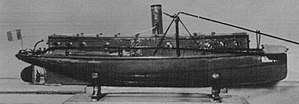NMS Rândunica
NMS Rândunica was the first torpedo boat of the Romanian Navy. A small British-built spar torpedo boat, she was commissioned in 1875 and fought during the Romanian War of Independence and during World War I.
 Rândunica after her 1900 refit (model) | |
| History | |
|---|---|
| Name: | Rândunica |
| Builder: | Yarrow and Company, Poplar, United Kingdom |
| Laid down: | 1875 |
| Launched: | 1875 |
| Commissioned: | 1875 |
| Out of service: | 1916? |
| Refit: | 1900, Galați shipyard |
| Fate: | Unknown |
| Service record | |
| Commanders: |
|
| Victories: | 1 monitor and 1 barge sunk |
| General characteristics | |
| Type: | Spar torpedo boat |
| Displacement: | 10 tons |
| Length: | 14 m (45 ft 11 in) |
| Beam: | 2.40 m (7 ft 10 in) |
| Draft: | 1 m (3 ft 3 in) |
| Propulsion: | 1 steam engine, 1 shaft |
| Speed: | 8 knots (15 km/h; 9.2 mph) |
| Complement: | 5 |
| Armament: |
|
Construction and specifications
Rândunica was built by Yarrow and Company in the United Kingdom,[1] and was commissioned two years before the start of the Romanian War of Independence. During the war, she was armed with a single spar torpedo.[2] In 1900, she was rebuilt at the Galați shipyard in Romania, having the following specifications: displacement of 10 tons, length of 14 meters, beam of 2.40 meters, draught of 1 meter, top speed of 8 knots and crew of 5.[3]
Service
Romanian War of Independence
In 1877, during the Romanian War of Independence, according to a Russian-Romanian treaty signed in April that year, Rândunica served under joint Romanian-Russian command. She was also known as Tsarevich by the Russians. Her crew consisted of two Russian Lieutenants, Dubasov and Shestakov, and three Romanians: Major Murgescu (the official liaison officer with the Russian headquarters), an engine mechanic and a navigator. The attack of Rândunica took place during the night of 25–26 May 1877, near Măcin. As she was approaching the Ottoman monitor Seyfi, the latter fired three rounds at her without any effect. Before she could fire the fourth round, Rândunica's spar struck her between the midships and the stern. A powerful explosion followed, with debris from the Ottoman warship raising up to 40 meters in the air. The half-sunk monitor then re-opened fire, but was struck once again, with the same devastating effects. The crew of Seyfi subsequently fired their rifles at Rândunica, as the latter was retreating and their monitor was sinking. Following this action, Ottoman warships throughout the remainder of the war would always retreat upon sighting spar torpedo boats. The Russian Lieutenants Dubasov and Shestakov were decorated with the Order of St. George, while Major Murgescu was decorated with the Order of Saint Vladimir as well as the Order of the Star of Romania. Rândunica was returned to full Romanian control in 1878, after the Russian ground forces had finished crossing the Danube.[4][5]
The Ottoman monitor Seyfi was a 400-ton ironclad warship, with a maximum armor thickness of 76 mm and armed with two 120 mm guns.[6]
World War I
Rândunica was modernized in 1900 at the Galați shipyard, most notably being fitted with a superstructure for better crew living conditions.[7]
On 27 August 1916, just after Romania declared war on Austria-Hungary, Rândunica attacked the Austro-Hungarian Danube Flotilla stationed in the Bulgarian port of Ruse. Commanded by Captain Aurel Negulescu, she was fitted with two torpedoes in wooden tubes. In the evening of 27 August, she launched her two torpedoes at one of the Austro-Hungarian monitors, but only one barge loaded with fuel was struck, which exploded and sank. The Austro-Hungarian warships subsequently retreated 130 km West along the Danube, stopping at Belene and taking extensive defensive measures.[8][9]
Her post-1916 fate is unknown.
References
- "Nave românești – Episodul 1.0: Torpiloarele". rumaniamilitary.ro (in Romanian). Retrieved 22 September 2017.
- Cristian Crăciunoiu, Romanian navy torpedo boats, Modelism, 2003, pp. 13-18
- Marie Maurice Clément Raoul Testu de Balincourt, P. Vincent-Bréchignac, Henri Le Masson, Jean Labayle Couhat, M. Bernard Prézelin, Les Flottes de combat 1940-1942, Challamel Publishing, 1942, p. 644
- Mihai Georgescu, Warship International, 1987: The Romanian Navy's Torpedo Boat Rindunica
- Cristian Crăciunoiu, Romanian navy torpedo boats, Modelism, 2003, pp. 13-18
- Navypedia: HİZBER river monitors (1876)
- Mihai Georgescu, Warship International, 1987: The Romanian Navy's Torpedo Boat Rindunica
- Raymond Stănescu, Cristian Crăciunoiu, Marina română în primul război mondial, Modelism, 2000, pp. 73-76
- Michael B. Barrett, Prelude to Blitzkrieg: The 1916 Austro-German Campaign in Romania, Indiana University Press, 2013, p. 6